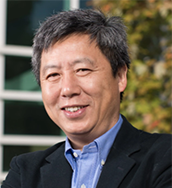New book outlines how students can become 'self-determined learners'
LAWRENCE — One major disruptor of the COVID-19 crisis has been the unprecedented need for millions of students to continue their education outside of a traditional classroom setting. But the crisis could be an opportunity to give students ownership of their own education and become the model for a new approach that replaces an increasingly inadequate system of standardized education. A new book by University of Kansas education researchers explores self-determined learning and how students, teachers and communities can make it a reality.
 “Teaching Students to Become Self-Determined Learners,” by Michael Wehmeyer and Yong Zhao, was written before shuttered schools and online learning were an everyday reality. Published this month, it is designed to help educators give students autonomy to guide their own education, and it offers strategies of how to implement the approach while supporting students.
“Teaching Students to Become Self-Determined Learners,” by Michael Wehmeyer and Yong Zhao, was written before shuttered schools and online learning were an everyday reality. Published this month, it is designed to help educators give students autonomy to guide their own education, and it offers strategies of how to implement the approach while supporting students.
Wehmeyer, chair of KU’s No. 1-rated Department of Special Education and Ross and Marianna Beach Distinguished Professor of Special Education, and Yong Zhao, Foundation Distinguished Professor of Educational Leadership & Policy Studies, collaborated on the book when they realized how closely their work aligned. Wehmeyer researches self-determination, or giving students with disabilities a role in determining what they learn, what goals they set for life, employment and other aspects of their future. Zhao has written extensively about customizing education for individual students and transforming the American education system by empowering youths and supporting their individual abilities.
 Parents want their children to take initiative and responsibility, as clearly illustrated during the current crisis.
Parents want their children to take initiative and responsibility, as clearly illustrated during the current crisis.
“The ability and desire to take initiative is taken out by schools that want you to recite answers to standardized questions,” Zhao said. “Mike’s work looks at how to not suppress that desire, but to encourage it. When children are on their own, how do they learn? It’s a matter of self-determination.”
The book opens with the story of an underperforming student who did just that. When Sam Levin told his mother how disappointed he was with school, she challenged him to do something about it. So he initiated an experiment in which he and his peers designed their own curriculum, decided what they wanted to learn about, held each other accountable and exchanged feedback in place of traditional grades. The project was so successful it spawned a book, national media coverage and continued success with greater student achievement and engagement among those who have taken part.
In the following chapters, Wehmeyer and Zhao further explore and define student ownership and self-determined learning, and they detail how educators can promote the concepts with their students. They also explore the importance of autonomy and choice for all. When adults learn new things, it is usually because they want to or the subject matter is of personal or professional value. That option is not given to children, though, who are given assignments and curriculum that have changed little in decades, other than to increasingly emphasize standardized testing. Wehmeyer has performed self-determination interventions for students with and without disabilities, and he shares evidence of how the model improves outcomes for all.
“This book allowed me to really focus in on the idea of self-determined learning for all,” Wehmeyer said. “The publisher, ASCD, is not disability-specific and was supportive of the idea of young people taking ownership of their own learning.”
The authors share how the idea of self-determined learning can reach a wider audience of students, how educators can enable conditions for it and specific teaching strategies to foster the qualities in all learners. They also explore the role of assessment and technology for student ownership and self-determined learning.
Wehmeyer said he often hears from educators who are intrigued by the idea of self-determined learning but claim they don’t have the time or ability to implement the approach. Zhao added that not only can the approach work, but methods of implementing it have been tested. Those strategies will help educators sustain the approach from one school year to the next.
When schools reopen their doors, they will have a unique opportunity to help students take ownership of their learning, and “Teaching Students to Become Self-Determined Learners” can help make it a reality.
“The idea of the book is you own the design of your own learning. That skill can be taught,” Zhao said. “We’ve tried to make this book as accessible as possible. That’s what Mike has taught me, making suggestions that are attainable and help all people reach their educational goals.”